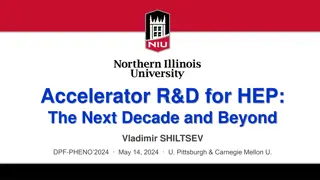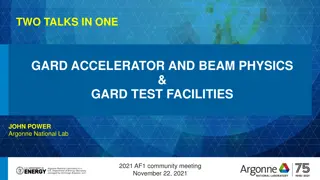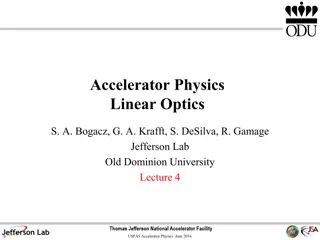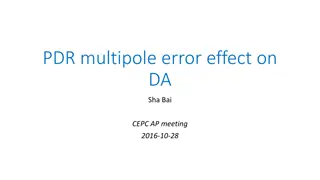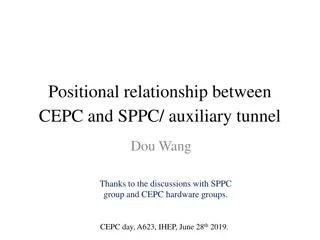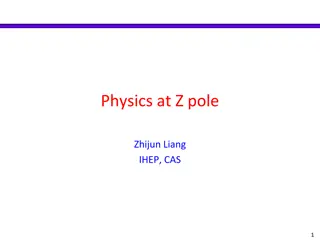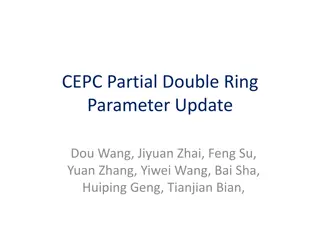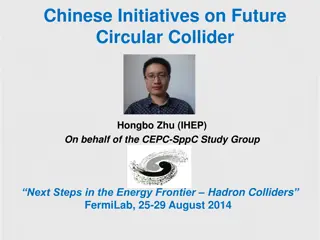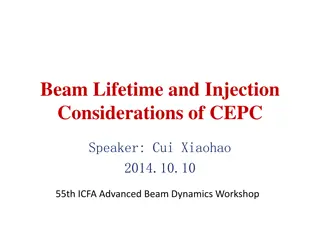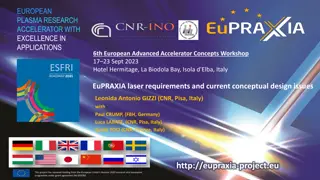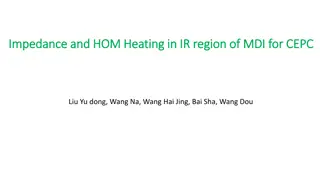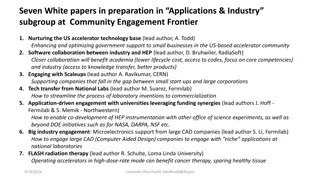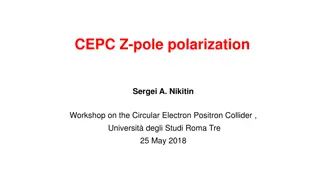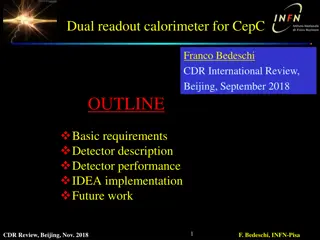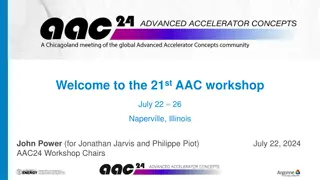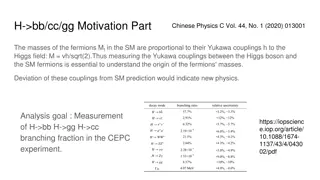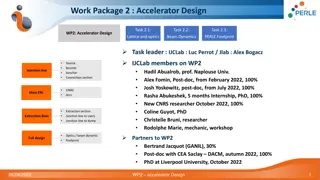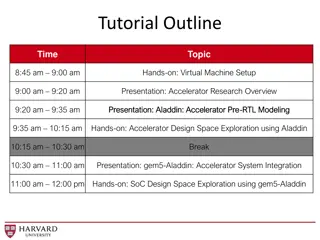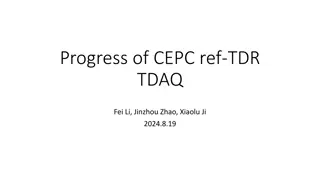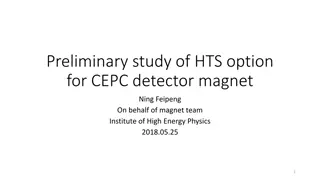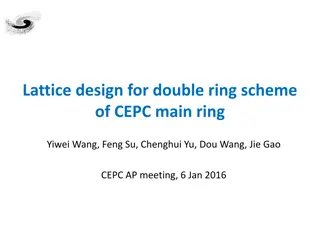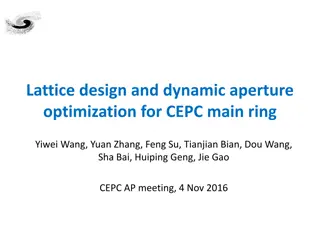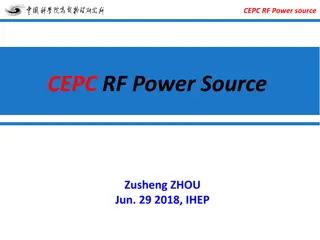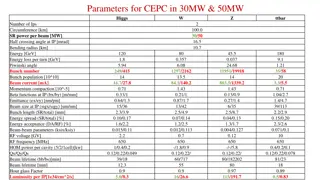Current Trends in High Energy Accelerator Developments
Explore the latest trends in high energy accelerator development as discussed by experts from various institutes around the world, including proposals from China and existing accelerator projects. Learn about the classification of accelerator facilities based on size and the ongoing evolution of fut
0 views • 36 slides
European Particle Physics Strategy Update & Accelerator R&D Overview
European Particle Physics Strategy updates serve as the cornerstone for long-term decision-making in the field, with a focus on Accelerator R&D for High Energy Physics. The update process involves key questions, R&D strategies for RF technologies, and implementation plans. Approved strategies emphas
7 views • 25 slides
Accelerator R&D for High-Energy Physics: Advancements and Future Prospects
Vladimir Shiltsev's presentation at DPF-PHENO 2024 discusses the evolution of accelerator R&D in high-energy physics, emphasizing the need for off-shore Higgs factories and targeted collider developments. The P5 recommendations underscore the importance of engaging in feasibility studies for advance
0 views • 28 slides
Government Contractors Basics for Beginners with OK APEX Accelerator
Explore the essentials of government contracting for beginners, including details about OK APEX Accelerator (formerly PTAC), the services offered, NAICS codes, SAM registration, and more. Learn how APEX Accelerator assists businesses in participating in government contracts, offering counseling, ass
0 views • 20 slides
Accelerator Technology R&D Targets and Sources Overview
The SnowMass2021 Accelerator Frontier AF7 focuses on Accelerator Technology R&D, exploring targets and sources such as high brightness electron sources, muon sources, and high intensity ion sources. The community planning meeting discussed various Letter of Interest submissions outlining innovative
0 views • 7 slides
Accelerator Science and Beam Physics Research Overview at US National Laboratories
US high-energy physics faces budget challenges despite the need for support to remain competitive. John Power from Argonne National Laboratory discusses the importance of funding for core research and accelerator science. The GARD program in the Department of Energy Office of High Energy Physics pro
0 views • 25 slides
Linear Beam Optics and Particle Motion in Accelerator Physics
Explore the fundamental concepts of linear beam optics and particle motion in accelerator physics, covering topics such as design trajectory, path length, phase advance, transfer matrix, and more. Understand the intricacies of designing accelerators and the mathematical representations involved in o
0 views • 78 slides
Analysis of Multipole Error Effects on Beam Dynamics in CEPC Accelerator
The content discusses the impact of multipole errors on the beam dynamics at the CEPC Accelerator, focusing on sources of error, measurements, and potential effects on the beam. The analysis includes different types of multipole errors, their sources, and the resulting changes in tune and emittance
4 views • 11 slides
Tasks of Alignment and Installation in CEPC Project
Tasks involved in the alignment and installation optimization of components in the Circular Electron Positron Collider (CEPC) project include control network construction, component installation, smooth alignment, and addressing any arising problems. The process is crucial for the successful operati
2 views • 19 slides
Design Considerations for CEPC Double Ring Scheme
The interaction region design for the partial double ring scheme at CEPC involves primary parameters, ARC lattice structures, tune shift effects, chromaticity corrections, and optimization strategies for 3rd order chromaticity. The integration of ARC and IR components aims to enhance chromaticity co
0 views • 9 slides
Positional Relationship Between CEPC and SPPC for Accelerator Physics
The positional relationship between the Circular Electron-Positron Collider (CEPC) and the Super Proton-Proton Collider (SPPC) involves careful considerations such as bypass tunnels, compatibility for future e-P collision programs, and shielding in the tunnel. Various scenarios are discussed regardi
0 views • 8 slides
Beam Energy Calibration with Compton Scattering Method
The CEPC beam energy calibration with Compton scattering method led by Yongsheng Huang and the CEPC energy calibration working group involves collaborations with various institutions and organizations. The project includes detailed physics requirements, system designs, and implementation plans for b
0 views • 14 slides
Advancements in Electroweak Precision Physics at Z Pole in CEPC
CEPC is making remarkable progress in electroweak precision physics at the Z pole, aiming for significant improvements in luminosity and precision measurements. Research on W/Z physics, branching ratios, gluon splitting, systematics reduction, and detector enhancements are key focus areas. CEPC expe
0 views • 14 slides
CO2-Laser-Driven Dielectric Laser Accelerator Proposal
Study and experimental demonstration of a CO2-laser-driven dielectric laser accelerator, addressing the limitations of current accelerator technologies by utilizing longer laser wavelengths for increased charge and improved beam control. The proposal aims to develop a novel in-vacuo scheme for ultra
0 views • 13 slides
CEPC Partial Double Ring Parameter Update
The CEPC Partial Double Ring Layout features advantages like accommodating more bunches at Z/W energy, reducing AC power with crab waist collision, and unique machine constraints based on given parameters. The provided parameter choices and updates aim to optimize beam-beam effects, emittance growth
0 views • 14 slides
Advancements in Chinese High-Energy Physics Research
Initiatives like the CEPC-SppC Study Group and Circular Electron Positron Collider (CEPC) showcase China's commitment to pioneering future collider projects. With a focus on the energy frontier, developments such as the upgrade to a 50-70 TeV pp collider indicate significant progress in the field. T
0 views • 32 slides
Comparison of Electricity Power Systems Between CEPC and FCCee
The evaluation and comparison of electricity power systems between the CEPC and FCCee accelerators reveal the power breakdowns, RF power consumption, magnet power supply, and overall power usage. Differences in power consumption for various components such as RF, magnets, and vacuum systems are high
0 views • 19 slides
Future of Accelerator Technologies: Enhancing Colliders and R&D Programs
The Accelerator Frontier Panel discusses the crucial components to enable future accelerators, emphasizing the need for a National Future Collider R&D Program, General Accelerator R&D, and adequate accelerator and test facilities. The message stresses the importance of an integrated future collider
0 views • 17 slides
Understanding Beam Lifetime and Injection Considerations at CEPC
Delve into the intricacies of beam lifetime and injection considerations at the CEPC, exploring topics such as beam-gas scattering, quantum lifetime, Touschek lifetime, and injection modes. Discover the crucial factors affecting beam stability and injection efficiency in particle accelerators.
0 views • 20 slides
European Plasma Research Accelerator with Excellence in Applications
The European Plasma Research Accelerator project, also known as EuPRAXIA, is a cutting-edge initiative that aims to develop a laser driver for advanced accelerator concepts. Led by a team of experts from various European countries, the project focuses on laser requirements, overall layout, thermal m
0 views • 33 slides
Impedance and HOM Heating in IR Region of MDI for CEPC
This study explores impedance and Higher Order Mode (HOM) heating in the Infrared (IR) region of MDI for the Circular Electron Positron Collider (CEPC). It discusses beam parameters, structure, layout of the vacuum chamber, and power deposition for different IR pipe models in detail. Additionally, i
0 views • 33 slides
Engaging Innovation in Accelerator Technology and Industry Partnerships
This collection of seven white papers explores a variety of topics in the fields of accelerator technology and industry collaborations. Topics range from nurturing the US accelerator technology base to enhancing government support for small businesses in the accelerator community. The papers also de
0 views • 6 slides
CEPC Collider Magnet System Overview
The CEPC collider magnet system comprises dual aperture dipole, dual aperture quadrupole, sextupole, and booster magnet designs. These magnets cover a significant portion of the 100km ring, addressing considerations such as manufacturing cost, power consumption, and field quality. The design focuses
1 views • 24 slides
Analysis of Magnet Errors in CEPC and LEP: Impact on Accelerator Performance
Investigating the effects of magnet errors on the Double Arc (DA) in the CEPC partial double ring, including alignment parameters, field errors, and their consequences on the orbit, tune, and stability of the beam. The study explores quadrupole, bending magnet, and sextupole field errors, highlighti
0 views • 13 slides
Radiative Polarization Techniques in CEPC for Precision Measurements of Z-Pole Mass
Prof. Jie Gao led discussions on the CEPC polarization program, focusing on obtaining transverse and longitudinal polarizations. The use of special wigglers to enhance the polarizing effect of the magnetic field was highlighted, reducing the time needed for radiative self-polarization. Strategies to
0 views • 22 slides
Beam Polarization Simulation Study for CEPC
Simulation study on beam polarization for the Circular Electron Positron Collider (CEPC) using the PTC Poly- morphic Tracking Code. The study includes orbital and spin tracking, equilibrium polarization calculation, and Monte-Carlo simulation of depolarization rate. Comparison with other Monte-Carlo
0 views • 20 slides
Dual-Readout Calorimeter for CepC: Overview and Key Features
The dual-readout calorimeter for CepC, as discussed in the International Review in Beijing, September 2018, is designed to optimize electromagnetic, hadronic, and jet resolution. With features like large sampling fraction for good EM resolution, event-by-event correction for EM fluctuations, and int
0 views • 22 slides
Advanced Accelerator Concepts Workshop Highlights and Vision
The 21st AAC workshop held in Naperville, Illinois, showcased research on advanced accelerator physics and engineering. Key themes included developing cost-effective facilities for high-energy physics and photon science, as well as compact facilities for industrial, medical, and security application
0 views • 10 slides
Measurement of Higgs Boson Yukawa Couplings and Branching Fractions in CEPC Experiment
The study focuses on measuring the Yukawa couplings between the Higgs boson and Standard Model fermions to understand fermions' masses and potential deviations indicating new physics. The analysis aims to measure Higgs decays to bb, cc, and gg at the CEPC experiment through event selection criteria,
0 views • 8 slides
Physics Workshop in November: Topics, Analysis, and Collaboration
Workshop in November will feature parallel sections on physics and simulations under detector section, with a focus on HL-LHC and CEPC challenges, EFT, new physics perspectives, and fast simulation for CEPC. A variety of topics including combination and kappa analysis, EFT implications, simulations,
0 views • 5 slides
Accelerator Design and DC Photogun Project Overview
This project overview outlines the tasks and goals related to Accelerator Design and DC Photogun within Work Packages 2 and 3. It includes details on team members, task leaders, activities, equipment, international collaborators, and identified contributors. Key focus areas encompass accelerator des
0 views • 13 slides
Accelerator Design Space Exploration Tutorial
This tutorial covers hands-on activities and presentations on virtual machine setup, accelerator research overview, RTL modeling, design space exploration using Aladdin, gem5-Aladdin for system integration, and SoC design space exploration. Aladdin, a pre-RTL power-performance accelerator simulator,
0 views • 52 slides
Updates on CEPC Project Progress and Meetings for August 2024
This update covers the progress of CEPC project with a focus on the Technical Design Report (TDR), including TDAQ developments by Fei Li, Jinzhou Zhao, and Xiaolu Ji. It outlines periodic meetings, work plans, and group activities for August 2024. The Build Working Group's activity involving simulat
0 views • 4 slides
Analysis of Bunch Lengthening in CEPC for Different Design Parameters
This study explores bunch lengthening in the Circular Electron Positron Collider (CEPC) for various design parameters, analyzing a 54 km design scheme, a 61 km design scheme, and a 100 km design scheme. The analysis includes the theoretical framework used, equations for bunch lengthening, and conclu
1 views • 15 slides
Preliminary Study of HTS Option for CEPC Detector Magnet
This study explores the use of high-temperature superconductors (HTS) for the CEPC detector magnet, focusing on Bi-2223, Bi-2212, and YBCO conductors. It discusses the properties of each conductor, their suitability for the magnet, and the decision to choose YBCO. The advantages and challenges of ut
0 views • 14 slides
CEPC Main Ring Double Ring Scheme Lattice Design
Lattice design and parameters for the double ring scheme of the Circular Electron Positron Collider (CEPC) main ring discussed at the CEPC AP meeting in January 2016. The outline covers the CEPC parameters for C=100km, including the lattice design and geometry for different regions. Details on energ
0 views • 14 slides
Dynamic Aperture Optimization for CEPC Main Ring
Lattice design and dynamic aperture optimization for the Circular Electron Positron Collider (CEPC) main ring were discussed, focusing on maximizing the dynamic aperture through lattice configurations in the ARC region, interaction region, and partial double ring region. Various strategies such as c
0 views • 14 slides
CEPC RF Power Source Overview
The CEPC RF Power Source involves high-power RF sources for accelerating and stabilizing particles in the Collider system. It includes design elements, efficiency considerations, and operational cost impacts. The transmission system utilizes superconducting cavity technology to meet power demands ef
0 views • 24 slides
CEPC Time of Flight and Outer Tracker with LGAD Updates
Updates on the progress of CEPC's Time of Flight and Outer Tracker with LGAD by Yunyun Fan from IHEP. The information covers sensor design, CEPCSW progress, mechanics design for cooling the ASIC, hit rate estimations for electronics, and backups. Collaboration with Italian colleagues is highlighted
0 views • 7 slides
Parameters and Results for CEPC in 30MW & 50MW
Parameters and results for the Circular Electron Positron Collider (CEPC) operating at 30MW and 50MW including information on the Higgs, W, Z, and ttbar processes. The data covers various aspects such as the number of IPs, circumference, power per beam, bending radius, energy, beam properties, beam-
0 views • 7 slides


